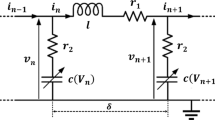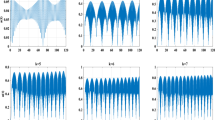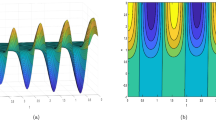Abstract
A noticeable research topic in optics is optical phenomena associated with the nonstatic waves. If the parameters of a medium vary by a periodic or randomly exerted perturbation, the waves become nonstatic, leading to a variation in their shapes. The decay of wave amplitudes through dissipation is also an outcome of wave nonstaticity. In this research, we demonstrate that Schrödinger equation allows nonstatic quantum waves even in the situation where the waves neither suffer perturbation nor undergo dissipation. The time behavior of nonstatic waves in such a static environment is investigated in detail in the Fock state at first. And then, we extend our development for such a peculiar wave characteristic to the case of a Gaussian wave evolution which resembles the behavior of classical states. It is shown how to define a quantitative nonstaticity measure which can be used universally beyond the Fock-state nonstatic waves. Understanding the characteristics of nonstatic-wave phenomena may not only provide deeper insight into the essence of nature, but is helpful for practical applications of the wave nonstaticity in science and technology of electromagnetic wave modulations.






Similar content being viewed by others
References
Walther, H., Varcoe, B.T.H., Englert, B.G., Becker, T.: Cavity quantum electrodynamics. Rep. Prog. Phys. 69(5), 1325–1382 (2006). https://doi.org/10.1088/0034-4885/69/5/R02
Josephson, B.D.: Possible new effects in superconductive tunnelling. Phys. Lett. 1(7), 251–253 (1962). https://doi.org/10.1016/0031-9163(62)91369-0
Habibi, M., Ghamari, F.: Investigation of non-stationary self-focusing of intense laser pulse in cold quantum plasma using ramp density profile. Phys. Plasm. 19(1), 113109 (2012). https://doi.org/10.1063/1.4768221
Savage Jr., R.L., Joshi, C., Mori, W.B.: Frequency upconversion of electromagnetic radiation upon transmission into an ionization front. Phys. Rev. Lett. 68(7), 946–949 (1992). https://doi.org/10.1103/PhysRevLett.68.946
Shvartsburg, A., Petite, G.: Instantaneous optics of ultrashort broadband pulses and rapidly varying media. Prog. Opt. 44, 143–214 (2002). https://doi.org/10.1016/S0079-6638(02)80016-6
Shah, S.M., Samar, R., Raja, M.A.Z.: Fractional-order algorithms for tracking Rayleigh fading channels. Nonlinear Dyn. 92(3), 1243–1259 (2018). https://doi.org/10.1007/s11071-018-4122-4
Akhmanov, S.A., Sukhorukov, A.P., Chirkin, A.S.: Nonstationary phenomena and space–time analogy in nonlinear optics. Soviet Phys. JETP 28(4), 748–757 (1969)
Bitouk, D.R., Fedorov, M.V.: Non-stationary scattering of wave-packets. Opt. Express 2(10), 404–410 (1998). https://doi.org/10.1364/OE.2.000404
Wu, J.: Riemann–Hilbert approach of the Newell-type long-wave-short-wave equation via the temporal-part spectral analysis. Nonlinear Dyn. 98(1), 749–760 (2019). https://doi.org/10.1007/s11071-019-05226-9
Angelow, A.K., Trifonov, D.A.: Dynamical invariants and Robertson–Schrödinger correlated states of electromagnetic field in nonstationary linear media. AIP Conf. Proc. 1340(1), 221–233 (2011). https://doi.org/10.1063/1.3582752
Zhaqilao, Z.: Nonlinear dynamics of higher-order rogue waves in a novel complex nonlinear wave equation. Nonlinear Dyn. 99(4), 2945–2960 (2020). https://doi.org/10.1007/s11071-019-05458-9
Vozianova, A., Yeliseyev, S., Nerukh, A.: Focusing of pulses by plane boundary of nonstationary medium. In: Proceedings of the 3rd International Conference on Ultrawideband and Ultrashort Impulse Signals, Sevastopol, Ukraine, pp. 266–268 (2006). https://doi.org/10.1109/UWBUS.2006.307225
Shvartsburg, A.B.: Optics of nonstationary media. Phys. Usp. 48(8), 797–824 (2005). https://doi.org/10.1070/PU2005v048n08ABEH002119
Ankiewicz, A., Akhmediev, N.: Rogue wave-type solutions of the mKdV equation and their relation to known NLSE rogue wave solutions. Nonlinear Dyn. 91(3), 1931–1938 (2018). https://doi.org/10.1007/s11071-017-3991-2
Dodonov, A.V.: Photon creation from vacuum and interactions engineering in nonstationary circuit QED. J. Phys. Conf. Ser. 161(1), 012029 (2009). https://doi.org/10.1088/1742-6596/161/1/012029
Yang, L., Cai, K., Shi, J., Xie, Y.M., Qin, Q.-H.: Nonlinear dynamic behavior of a clamped–clamped beam from BNC nanotube impacted by fullerene. Nonlinear Dyn. 96(2), 1133–1145 (2019). https://doi.org/10.1007/s11071-019-04845-6
Trofimov, V.A., Lysak, T.M., Loginova, M.M.: Laser pulse self-similar propagation in a medium with noble metal nanoparticles under conditions of non-stationary processes. In: Proceedings of SPIE 10730, Nanoengineering: Fabrication, Properties, Optics, and Devices XV, 1073014 (2018). https://doi.org/10.1117/12.2322617
Nerukh, A., Benson, T.: Non-stationary Electromagnetics: An Integral Equations Approach, 2nd edn. Pan Stanford Publishing Pte. Ltd., Singapore (2019)
Mendonça, J.T.: Theory of Photon Acceleration. CRC Press, Bristol (2000)
Mendonça, J.T., Oliveira e Silva, L.: Regular and stochastic acceleration of photons. Phys. Rev. E 49(4), 3520–3523 (1994). https://doi.org/10.1103/PhysRevE.49.3520
Wilks, S.C., Dawson, J.M., Mori, W.B., Katsouleas, T., Jones, M.E.: Photon accelerator. Phys. Rev. Lett. 62(22), 2600–2603 (1989). https://doi.org/10.1103/PhysRevLett.62.2600
Medjber, S., Bekkar, H., Menouar, S., Choi, J.R.: Quantization of a 3D nonstationary harmonic plus an inverse harmonic potential system. Adv. Math. Phys. 2016, 3693572 (2016). https://doi.org/10.1155/2016/3693572
Dodonov, V.V., Man’ko, V.I.: Loss energy states of nonstationary quantum systems. Nuovo Cimento B 44(2), 265–274 (1978). https://doi.org/10.1007/BF02726792
Vorgul, I.: On Maxwell’s equations in non-stationary media. Phil. Trans. R. Soc. A 366(1871), 1781–1788 (2008). https://doi.org/10.1098/rsta.2007.2186
Wei, L., Wang, Y.: Quantum ion-acoustic waves in single-walled carbon nanotubes studied with a quantum hydrodynamic model. Phys. Rev. B 75(19), 193407 (2007). https://doi.org/10.1103/PhysRevB.75.193407
Shukla, P.K., Ali, S., Stenflo, L., Marklund, M.: Nonlinear wave interactions in quantum magnetoplasmas. Phys. Plasm. 13(11), 112111 (2006). https://doi.org/10.1063/1.2390688
Hiley, J.: Non-commutative quantum geometry: a reappraisal of the Bohm approach to quantum theory. In: Elitzur, A.C., Dolev, S., Kolenda, N. (eds.) Quo Vadis Quantum Mechanics? The Frontiers Collection. Springer, Berlin (2005). https://doi.org/10.1007/3-540-26669-0_16
Kong, O.C.W.: A geometric picture of quantum mechanics with noncommutative values for observables. Results Phys. 19, 103636 (2020). https://doi.org/10.1016/j.rinp.2020.103636
Choi, J.R., Yeon, K.H., Nahm, I.H., Kim, S.S.: Do the generalized Fock-state wave functions have some relations with classical initial condition? Pramana J. Phys. 73(5), 821–828 (2009). https://doi.org/10.1007/s12043-009-0150-4
Trueba, J.L.: Electromagnetic knots and the magnetic flux in superconductors. Ann.Fond. Louis Broglie 33(1–2), 183–192 (2008)
Robinett, R.W., Bassett, L.C.: Analytic results for Gaussian wave packets in four model systems: I. Visualization of the kinetic energy. Found. Phys. Lett. 17(7), 607–625 (2004). https://doi.org/10.1007/s10702-004-1117-9
Robinett, R.W., Bassett, L.C.: Analytic results for Gaussian wave packets in four model systems: II. Autocorrelation functions. Found. Phys. Lett. 17(7), 645–661 (2004). https://doi.org/10.1007/s10702-004-1119-7
Schiff, L.I.: Quantum Mechanics, 3rd edn, pp. 74–76. McGraw-Hill, New York (1968)
Gradshteyn, I.S., Ryzhik, I.M.: Tables of Integrals and Products, 8th edn, p. 811. Elsevier, Amsterdam (2015)
Erdély, A.: Higher Transcendental Functions, vol. II. McGraw-Hill, New York (1953)
Acknowledgements
This work was supported by the National Research Foundation of Korea (NRF) grant funded by the Korea Government (MSIT) (No. NRF-2016R1D1A1A09919503).
Author information
Authors and Affiliations
Corresponding author
Ethics declarations
Conflicts of interest
The author declares no conflict of interest.
Additional information
Publisher's Note
Springer Nature remains neutral with regard to jurisdictional claims in published maps and institutional affiliations.
Appendices
Appendix A: Evaluation of the Gaussian wave function
In order to depict the probability density associated with the Gaussian wave function given in Eq. (8), it is necessary to derive its analytical expression. For this purpose, we first evaluate \(c_n\) using the basic relation which is
A minor calculation after inserting the initial wave functions \(\langle q |\psi _n(0) \rangle \) and Eq. (7) into the above equation leads to
Here, we have used the integral formula of the form [34]
Now, from the substitution of Eq. (A2) into Eq. (8) in the text, we have
where \(\Theta (t) = \omega \int _0^t f^{-1}(t'){\text {d}}t'\), and
In the derivation of Eq. (A4), Mehler’s formula [35] has been used:
If we confine the range of \(\varphi \) within \(-\pi /2 \le \varphi < \pi /2\) for convenience, \(\Theta (t)\) can be evaluated, leading for \(t\ge 0\) to
where
In Eq. (A11), u[t] is the step function (the Heaviside step function).
We can also have the probability density associated with the wave function given in Eq. (A4) from a straightforward evaluation as
where
Equation (A12) with Eqs. (A13)–(A16) has been used in the plot of Fig. 5 in the text.
Appendix B: Evaluation of the measure of nonstaticity for the Gaussian wave
For the Gaussian wave, the measure of nonstaticity is determined from \({{\mathcal {W}}}\). Let us divide \({{\mathcal {W}}}\) as the real and imaginary parts, such that
A straightforward evaluation using Eq. (A5) gives
where
From these expressions, we easily have \( {{{\mathcal {W}}}_\mathrm{I}}/{{{\mathcal {W}}}_\mathrm{R}} \) given in Eq. (9) in the text.
Rights and permissions
About this article
Cite this article
Choi, J.R. On the possible emergence of nonstatic quantum waves in a static environment. Nonlinear Dyn 103, 2783–2792 (2021). https://doi.org/10.1007/s11071-021-06222-8
Received:
Accepted:
Published:
Issue Date:
DOI: https://doi.org/10.1007/s11071-021-06222-8




